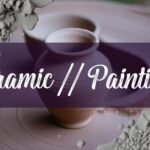Ceramic surface design is where the magic happens, transforming a simple clay form into a unique piece of art. It encompasses a vast range of techniques, each offering its own distinct aesthetic and tactile qualities. From the earliest hand-applied methods to the latest in digital technology, the possibilities for decorating ceramics are virtually endless. Let’s dive into some of these fascinating techniques that can elevate your pottery from functional to fabulous. For additional information, check out this article on unlocking ceramic surface design.
One of the most accessible and expressive methods is slip decoration. Slip, essentially liquid clay, can be applied in numerous ways to alter the color and texture of your piece. Dipping, brushing, and pouring are straightforward ways to cover large areas, while slip trailing—using a nozzle or syringe to apply lines and patterns—allows for more intricate, raised designs. Then there’s sgraffito, where you apply a layer of colored slip and then scratch through it to reveal the clay beneath, creating a beautiful contrast. For those who love detail, mishima, or inlay, involves incising patterns and filling them with a contrasting slip or glaze, then scraping back the surface for a crisp, inlaid effect. And let’s not forget burnishing, the ancient technique of polishing the clay surface to a shine before firing, resulting in a smooth, reflective finish without glaze. More information on this can be found here in this article about terra sigillata.
This helpful video demonstrates a step by step guide on how to glaze ceramic sculptures:
The techniques listed above all create amazing and interesting effects on the pottery piece, and are staples in any experienced potter’s toolbelt. Make sure to experiment around with them to see which ones you prefer!
Glazes are another cornerstone of ceramic surface design, offering not only color but also protection and functionality. Applying glazes can be as simple as dipping, brushing, or spraying. For the adventurous, crystalline glazes can create stunning, unique patterns with visible crystals forming during a controlled cooling process. Beyond slips and glazes, directly altering the clay surface through carving and incising can add depth and texture, letting you sculpt your designs right into the form. Stamping and stenciling offer ways to repeat patterns, adding rhythm and complexity to your work; you can press objects into the clay or use cut-out templates to apply slip or glaze.
Painting on ceramics opens up even more possibilities. Underglaze painting involves applying designs to bisque-fired pottery, covering them with a transparent glaze, and firing again for a vibrant, durable finish. Overglaze painting, or enamel painting, allows you to add decoration over a glazed surface, followed by a lower-temperature firing. Decals offer a convenient way to transfer pre-printed images, while digital printing allows for incredibly precise and complex patterns that would be difficult to achieve by hand. The beauty of ceramic surface design lies in the freedom to mix and match these techniques, creating your own unique style and pushing the boundaries of what’s possible with clay.





